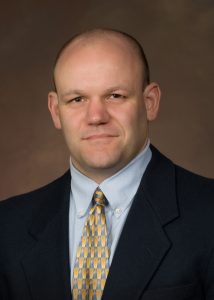 We sat down with Tony Surace, the Director for the Center for Interprofessional Learning and Simulation (CILS) to talk about the center and how Daemen University students are benefiting from this versatile space on campus.
We sat down with Tony Surace, the Director for the Center for Interprofessional Learning and Simulation (CILS) to talk about the center and how Daemen University students are benefiting from this versatile space on campus.
Tell us about the CILS
The Center for Interprofessional Learning and Simulation is a facility within the Research and Information Commons (RIC) on Daemen’s campus.The center is composed of 10 rooms and one large conference room that can accommodate up to 24 people. All of the rooms are adjustable meaning you can move the furniture in and out and create the desired environment particular to certain curriculum areas. For example, the rooms can be set up like a medical office, business office, educational space, counseling room or for a patient exam. The two larger rooms at the end of the hall are exam rooms frequently used for OB GYN exams by our Physician Assistant students.
The rooms provide a space for simulated scenarios within different curriculum areas. A unique aspect of the CILS is that we use standardized patients, or paid actors, for these simulations as opposed to mannequins like many other institutions. For example, social work students are able to participate in simulated interviews with a wide range of patients and clients. Physical Therapy and Physician Assistant students can work with standardized patients to do full evaluations like physical exams, ear nose and throat exams and cardiac evaluations before they go through their clinicals. They are given the opportunity to practice through real life scenarios in an environment that mimics the closest situations to real life as possible. Daemen students can hone their skills through low risk arrangements and are better prepared to enter the workforce because of the opportunity to learn at the CILS.
What is the Vault Program?
The Vault Program is an intelligent video solutions program that is connected to each of the ten rooms within the CILS. Based out of the conference room, the program records the sessions in the rooms and allows students to be monitored without the presence of the faculty in the room. Professors can watch the simulation, create markers within the recording and are able to give more effective feedback to their students on their performance. This alleviates unnecessary pressure on the student and creates an environment of learning that is more impartial and accessible.
What are the main objectives of the CILS?
First, to make sure that the students have a good experience within the CILS and can effectively learn their curriculum. This means making sure that the instructors are scheduled properly, they commit to those times and that we are prepared to take the students through the simulations unique to their area of study.
Secondly, promoting the CILS through professional development through community based businesses. We partner with outside organizations to use the facilities on non-curriculum days for professional advancement.
Thirdly, we are building continuing education through a computer based program called Digital Chalk. Through this program, we will upload continuing education courses that Daemen faculty create. Professionals from all over New York state will be able to go online, purchase the course, and receive their continuing education units to maintain licenses and for advancement of their own career. Our goal is to launch the program over the Summer.
